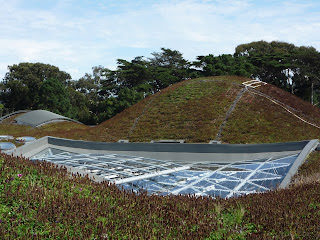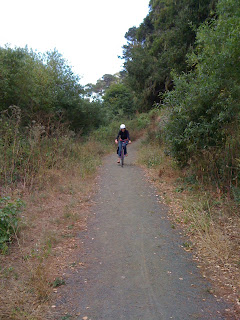Day three, we woke up in a 'Good Night Inn' in Salinas, which makes two bad ways to wake up. Not that Salinas is so terrible, it's just a truck stop town (literally, the motel parking lot had a large section devoted to semi parking) with not one building more than 20 years old. And not that the Good Night Inn was so terrible either, for the money (the cheapest motel in three towns) it was surprisingly not gross. But still, we're basically city folk, so we were out of our element. Not too much time passes, however, before we are back in our element: stuck in traffic in 'The City,' as the locals call it (not Frisco, unless you want to start a fight).
The California Academy of Sciences, in Golden Gate Park, was pretty cool. Amazingly, having come from the
Monterey Bay Aquarium just the day before, I was not disappointed by the Aquarium they had there (and I don't like fish
that much). But the crown jewel here is really the tropical biosphere (literally, a giant sphere of Plexiglas). You walk around a path slowly sinking into the ground towards the entrance, which is kind of like an airlock to keep the
hundreds of live butterflies inside the sphere. The sphere is a living museum of the tropical rainforests, full of specimens of plants, insects, snakes, amphibians and birds. The more venomous and carnivorous specimens are caged, but the butterflies and many birds roam free, and occasionally engage in human encounters.


You walk up a twisted path that takes you through the different layers of the
rainforest, and at the top, there is an elevator back down, guarded by two attendants armed with butterfly nets. I am not kidding. The elevator lets you off in the Aquarium, so I recommend going that way first.
Another interesting feature: the green roof. The entire roof of the Institute (minus skylights for day lighting and a small paved area for guest observation) is planted with indigenous species of grasses, flowers, and other small plants. It is an ongoing experiment, actually, they are watching how the species interact with each other. So, I thought I would take a second to talk about the many, many reasons I love green roofs.

California Academy of Sciences roof
Green roofs provide many practical functions for a building, whether residential or commercial, single family or multi-unit. For one thing, they provide excellent insulation, which can help to reduce heating and cooling bills. If you live in a place with hot summers, they also actively cool off the roof using no energy whatsoever (the plants evaporate some of their water, which releases heat naturally). Also, if designed well, they provide usable open space for the occupants of the building, like adding a little extra park land to your site. If you commit to planting local species, you might not need to water them, and they can actually strengthen the local habitat by providing a safe haven where the bees can get and the local herbivores cannot. On the subject of water, if you live in an area with storm water runoff problems, green roofs help by absorbing excess instead of flushing it straight into the drain.
Finally, although they can cost more to install (extra structure to hold the extra weight), they actually require significantly less maintenance than traditional roofs, and can last many years longer before major repairs are required. In the long run, they can be much cheaper than many customary practices for roof construction.
Back to the trip, we capped the day off with an excellent meal in
Sonoma at
The Girl and the Fig, where I had sweet meats for the first time. Oddly enough, I had just heard an old episode of Good Food about someone cooking through the Whole Beast cookbook, so I was sharply curious about these lesser used pieces of animal flesh (the author of Whole Beast, utilizing all of his British dry humor, said [roughly]: if you're going to kill something it is only polite to use the whole animal). And one the subject of food, now that I think of it, the cafeteria at the Institute was the
best cafeteria I have ever eaten at, bar none.
All in all a great day, but nothing that has happened so far was even close, really, to day four - the redwood forests.


